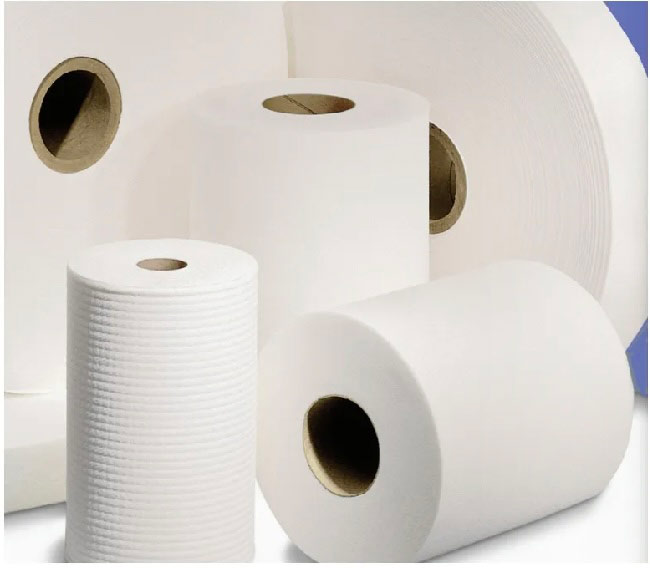Principles of Narrow Web Slitting
- Published: April 11, 2024
By Susan Stansbury, Industry Consultant
 For those veterans in the slitting-winding community, this commentary is not necessarily new information, but reviews are always good too. For newer industry participants, here are some notes for consideration.
For those veterans in the slitting-winding community, this commentary is not necessarily new information, but reviews are always good too. For newer industry participants, here are some notes for consideration.
James Weintraub of Dietze & Schell Manufacturing, working from South Carolina, reminds us of the three key aspects to analyze:
- Slit width;
- Material; and,
- Diameter.
"Modes of rewinding are critical as well," he said. "Center winding, center/surface, and surface winding are applicable. Also, duplex winding in many of these modes is important for larger diameters of inconsistent calipers.
This all applies to 'pancake' or narrow strait roll winding, traverse or parallel' winding is another factor." Universal Converting Equipment's X3 "is a narrow-width compact slitter that has equal capability to many much larger slitter rewinders," according to this UK and Tampa Florida company.
Equipment is available with razor, shear or crush cutting capabilities to handle papers, label stock, laminates, foils and films.
AZCO Corp of Fairfield, New Jersey, offers its narrow web slitter-rewinder designed for high-speed, precision cutting and rewinding while also removing trim and liner material.
Elite Cameron, with U.S. and UK locations, supplies three precision center-surface slitting machines for narrow widths. All their Centre Surface machines can be run in contact with a driven roll using soft nip technology. In one example, they provided a leading tape converter a machine equipped with dual axis, automatic knife positioning system for the shear knives.
Double E Group, with headquarters in Massachusetts, Appleton in Wisconsin, and in Italy, are among companies who specialize in slitting systems, knife holders, and material handling. Double E's drop-in slitting modules make uncomplicated upgrades.
Slit widths on narrow rolls are affected by both the material and desired diameter. For example, when I was a marketer in the silicone coating marketplace, we worked with those "slippery" materials, often at less than two-inch cuts, sometimes building just 14 to 18 inch diameters where no one wants the roll to telescope in your factory or at the customer's.
Materials are critically impactful, with various papers, from lightweight tissue to dual-sided rolls; films ranging from stiffer polyester to thin-stretchy polyethylene; and stability presented by machine-direction (MD) and cross-direction (CD) strength issues. When I worked at a nonwovens group of a major supplier and we looked at new machinery, we added millions to source a machine with a good balance of MD to CD, so that further converting would be a smoother process with less waste.
Nonwovens, in thin-to-thick choices, affect the selection of slitter-winders engineered to handle variation within the roll, dust buildup, and ease of changeovers.
Assessing substrates for slitting mode avoids the worst of factors including wrinkles, spreading and path problems. Sensors assist with detection.
The technical details affect narrow width slitting and all winding. Jeffrey Damour of Converter Accessory Corporation reminds us that handling trim with conveying systems is a special assessment: "Be careful when considering pneumatic trim removal to replace a trim winder or some other mechanical means, like a nip roll, to remove edge trim or other waste from a machine."
He said, "Oftentimes, mechanically driven trim and waste removal systems, like winders and nip rolls, will deliver a fairly consistent and relatively high (when compared to pneumatic waste removal) amount of web tension to the waste itself. This tension may be necessary to separate edge trim from the side of the web or slitter blade. If you are stripping a layer of laminated material from a base layer, label matrix from a release liner, for example, a fair amount of web tension may be necessary for the stripping operation." Further, "Pneumatic waste removal systems should not be used to control or generate web tension. They will not work well where web tension is required to separate waste trim or matrix from the web. However, pneumatic waste removal systems are an excellent choice for picking up and conveying separated edge trim, waste matrix or die-cut pieces from a waste generation point.
Pneumatic waste removal systems can convey waste from short to extremely long distances at maximum line speeds, increasing your product throughput."
Slitting-winding expert Dave Rumsom reminds us about the importance of knife sharpness, knife shape and set up geometrics." He also echoes that "material characteristics (toughness, flexibility), web winding process dynamics, tension, web speed, shear knife rotation speed and web CD control" play their roles in the process. Rumsom teaches the industry with "the 18+ Shear Slitting geometric, dynamic and material factors involved in winding to-spec finished rolls." Find him at: This email address is being protected from spambots. You need JavaScript enabled to view it..
Continued product development and activity in the narrow-width industry means there is an ongoing need to tune in.
About the Author
Susan Stansbury is also author of a new ebook, 14 Dinners and A Lunch (It's not about the food! It's Susan's stories about decades in the industry told around a series of meals.)




